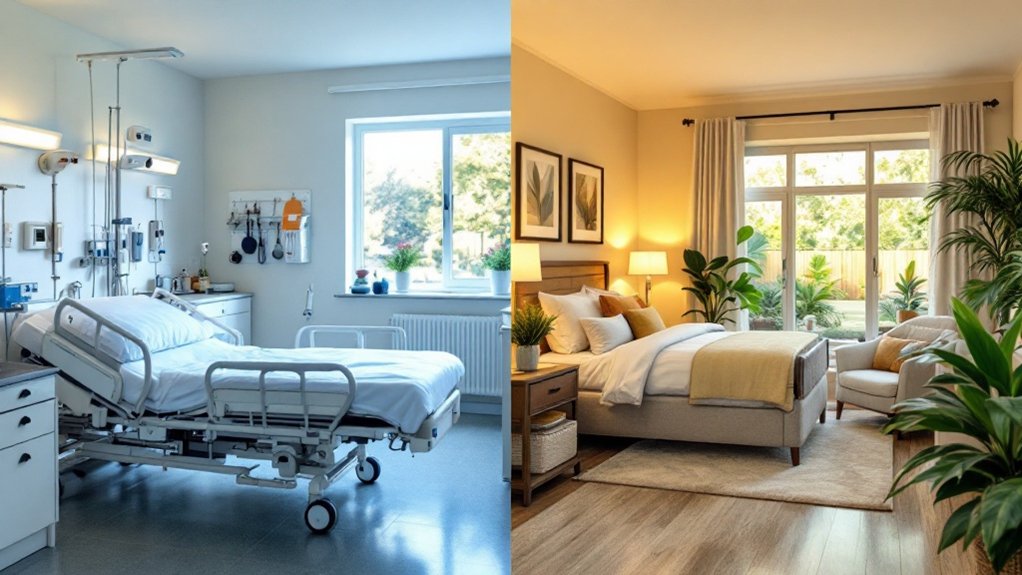Nursing homes and assisted living facilities serve distinct needs through fundamentally different care models. You'll find nursing homes provide intensive medical supervision with 24/7 skilled nursing staff at $9,000-$10,000 monthly, while assisted living emphasizes independence with basic medical support at roughly half the cost. Nursing home stays average 2.25 years with physician-ordered admission and greater insurance coverage, whereas assisted living residents typically remain 1-2 years in apartment-style settings. Understanding these operational contrasts will illuminate your ideal long-term care path.

While both nursing homes and assisted living facilities provide essential care for aging populations, their fundamental differences lie in the scope of medical services, cost structures, and living arrangements.
Nursing homes deliver extensive medical care through round-the-clock supervision and skilled nursing staff, whereas assisted living facilities concentrate on maintaining residents' independence while offering basic medical support and assistance with daily activities. The need for physician's orders is mandatory for nursing home admission, setting it apart from assisted living requirements. Assisted living facilities focus on providing quality of life through personalized care plans and greater autonomy.
You'll find that the financial implications between these options vary greatly, with nursing homes commanding substantially higher fees due to their intensive medical services and specialized staff requirements. The cost variance is significant, with nursing homes typically charging private room rates between $9,000 to $10,000 monthly.
Assisted living facilities typically cost up to 50% less than nursing homes, though you're more likely to secure insurance coverage, including Medicaid and Medicare, for nursing home care rather than assisted living expenses, which are mainly paid through personal funds.
The duration of residency differs markedly between these care options, with nursing home stays averaging 2.25 years or longer, while assisted living residents typically remain for 1-2 years.
Your length of stay often correlates directly with the progression of medical needs, with nursing home residents frequently requiring care until end of life or considerable medical improvement.
The physical environments reflect their distinct purposes, as you'll observe nursing homes structured similarly to medical facilities, often with shared rooms and specialized equipment, while assisted living facilities mirror residential communities with private rooms or suites.
This architectural divergence supports their respective care models, with nursing homes prioritizing medical accessibility and assisted living emphasizing independence and community living.
Medical service capabilities represent a vital distinguishing factor, as nursing homes provide skilled nursing care, therapy services, and management of complex medical conditions, while assisted living facilities offer basic medical oversight and medication management.
You'll find that social engagement opportunities exist in both settings, though assisted living facilities place greater emphasis on community activities and independent participation, whereas nursing homes must often modify social programming to accommodate residents' medical limitations.
Frequently Asked Questions
Can Couples Live Together in Nursing Homes or Assisted Living Facilities?
While you'll find that assisted living facilities commonly accommodate couples in private apartments with personalized care plans, nursing homes typically present more challenges for cohabitation.
Assisted living enables you to maintain an independent lifestyle together, sharing living spaces and activities while receiving individualized support.
However, you'll encounter more limitations in nursing homes due to their medical-focused, room-sharing structure and intensive care requirements.
What Happens if Residents Run Out of Money During Their Stay?
If you run out of money, Medicaid typically steps in to cover nursing home costs, provided you've depleted your assets to qualifying levels.
For assisted living, your options become more limited since Medicaid coverage varies considerably by state.
You'll need to verify your facility's specific policies, as some require upfront guarantees of 2-5 years of payments, while others may necessitate a shift to shared rooms or alternative accommodations.
Are Pets Allowed in These Facilities?
You'll find that pet policies vary considerably between facilities, with assisted living communities generally being more permissive than nursing homes.
Assisted living typically allows personal pets with size and breed restrictions, while nursing homes mainly limit animal interactions to supervised visits.
Both settings require proof of vaccinations and health screenings, though you'll need to verify specific policies with individual facilities, as regulations can differ substantially by location and facility type.
How Often Can Family Members Visit Residents?
You can expect multiple weekly visits to your loved one, though specific policies vary by facility.
Standard visiting hours typically run 8-12 hours daily, with most facilities allowing 1-2 hour visits per session.
You'll need to comply with the facility's protocols, including visitor caps (usually 2 people), PPE requirements, and potential advance scheduling.
During health emergencies, facilities may implement stricter limitations while maintaining compassionate care visits for end-of-life situations.
Can Residents Bring Their Own Furniture and Personal Belongings?
Your ability to bring personal furniture varies considerably between care settings, with assisted living offering greater flexibility for personalizing living spaces compared to nursing homes' more restricted policies.
While nursing homes typically provide essential furnishings and limit personal items for safety and space considerations, you'll find that assisted living communities encourage residents to create familiar environments with their belongings, subject to safety protocols and administrative approval.









